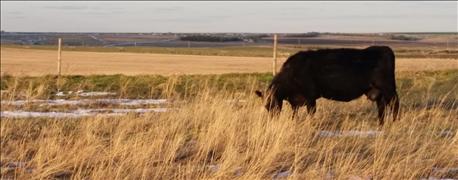November 23, 2016

Dung beetles, earthworms and pollinators are the good guys when it comes to the health of soil and grassland resources.
Allen Williams, founding partner and president of GFI LLC, an agriculture and food industry consulting firm, made a five-hour stop at Curtis at a November meeting with agriculture students, professors, and grazing lands and livestock managers at the Nebraska College of Technical Agriculture.
Williams shared his insights with an audience of 81 attendees during the evening program titled, "Dirt Rich or Dirt Poor: Principles of Soil Health, Adaptive Grazing and Cover Crop Livestock Integration."

HOOF TRAFFIC: While livestock graze, their hoof traffic helps incorporate nutrients into the soil. Also, dung beetles aid in decomposing animal waste and burrowing nutrients down into the soil profile. (Photo courtesy of NCTA News Service)
Aggie students enrolled in livestock management, production and range management courses at NCTA were assigned to attend and report on their findings to NCTA animal science professors Teri Jo Bek and Doug Smith.
Timely rains and soil moisture are critical to proper vegetative growth. Indicators of soil health below that vegetation can include presence of earthworms and dung beetles. For example, while livestock graze on pastures and grasslands, the action of their feet help to incorporate nutrients into the soil, and dung beetles aid in decomposing animal waste and burrowing the nutrients down into the soil profile.
"There are more than 70 types of dung beetles," Williams noted. "Those holes you see in a cow patty are dung beetles at work, taking the dung into the soil."
Williams encouraged producers to use soil tests to measure soil health and plan fertility programs for improving their soil conditions. Proper management of livestock and the grassland or crop resources improves soil tilth, thus enhancing plant vitality and reducing soil erosion by wind, lack of moisture and overgrazing.
He cited examples of poor resource management and how to improve conditions. As a land manager, consultant and business owner, Williams has been able to increase agricultural profitability through adaptive or intensive grazing by putting more livestock into smaller paddocks and grazing for very short periods of time, or increasing pressure to reduce or eliminate specific invasive species or weeds such as cedar trees.
Williams cited numerous case studies of soil and resource improvement by better managing manure distribution, choosing optimal grass varieties to match soil temperatures and climate, and incorporating cover crops into existing rotations and grasslands management.
Williams has consulted for more than 4,000 farmers and ranchers in the United States, Canada and Mexico. He holds animal science degrees from Clemson University and Louisiana State University.
The program was sponsored by Nebraska Extension with the Nebraska Grazing Lands Coalition and NCTA.
Source: NCTA News Service
You May Also Like




